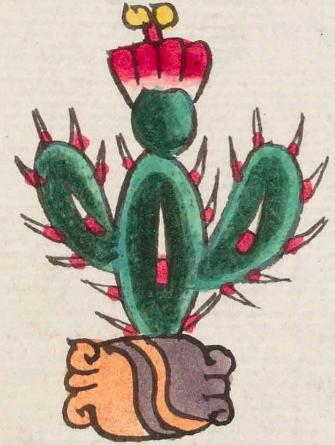Tenochtitlan (Mdz19r)
This compound glyph for the place name Tenochtitlan features two principal components, a stone (tetl) and an upright, tripartite, prickly pear cactus. The fruit for the cactus is the nochtli. The ligature ("ti") and the locative suffix, -tlan, are not shown visually. The rock or stone [tetl is horizontal in this case, and it is colored half purple and half terracotta-orange. Where the two colors meet there are wavy lines, one of each color, alternating. At each end of the stone are curling elements that are characteristic of representations of rocks and also found on mountains, caves, and the like. The cactus has a leader and two branches. These main parts are painted in two tones of green, light and dark, perhaps for dimensionality. Thorns cover the cactus, red at their base and white at their tips. At the top of the main part of the cactus there is a flower, green at the base (the receptacle or sepal), with petals that are white at their base but predominantly red, and, at the top of the flower are two yellow anthers with a red filament or stamen. The flower is the site that would produce or become the fruit.
Stephanie Wood
Gordon Whittaker's analysis of Tenōchtitlan translates the "noch" as cactus, which makes sense visually in this compound glyph, given that it is the full cactus that we see. It is curious that the gloss gives "nux" instead of "nuch" or "noch," although the x and ch do have a similar sound. One will find nox- instead of noch- at the start of the expression for nochpoch ("my daughter," from ichpochtli), for example. See also our compound glyph, Teonochtitlan (below), which is a different visual and phonetic version of what could be the same place name.
In some flowers, such as this one, the anthers are rather pronounced. The anthers are the flower parts that produce and provide the pollen, which has the reproductive capacity that has been compared in Western cultures to semen.
Stephanie Wood
tenuxtitlan.
Tenochtitlan.
Stephanie Wood
c. 1541, or by 1553 at the latest
Stephanie Wood
cactus fruits, tunas, flowers, stones, rocks, cacti, cactos, piedras, rocas, capitales, ciudades, altepetl, nombres de lugares

te(tl), stone or rock, https://nahuatl.wired-humanities.org/content/tetl
noch(tli), cactus fruit, https://nahuatl.wired-humanities.org/content/nochtli
tenoch(tli), prickly pear cactus, https://nahuatl.wired-humanities.org/content/tenochtli
-ti- (ligature), https://nahuatl.wired-humanities.org/content/ti
-tlan (locative suffix), https://nahuatl.wired-humanities.org/content/tlan
ichpoch(tli), daughter, https://nahuatl.wired-humanities.org/content/ichpochtli
"By the Rock Cactus" [Gordon Whittaker, Deciphering Aztec Hieroglyphs, 2021, 111]. "Place of the Cactus Fruit on the Stone" [Jongsoo Lee, The Allure of Nezahualcoyotl, 2008, 258.]
TE-NOCH.
Codex Mendoza, folio 19 recto, https://digital.bodleian.ox.ac.uk/objects/2fea788e-2aa2-4f08-b6d9-648c00..., image 48 of 188.
The Bodleian Libraries, University of Oxford, hold the original manuscript, the MS. Arch. Selden. A. 1. This image is published here under the UK Creative Commons, “Attribution-NonCommercial-ShareAlike 3.0 License” (CC-BY-NC-SA 3.0).








